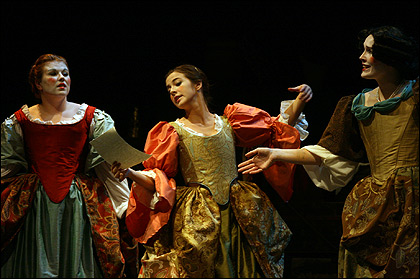
Object or Artist?
Playhouse Creatures questions womens role on stage
by Anna Grace
Norah Jones voice creeps seductively, plaintively over the audience, quieting us while ghosts of 17th-century actresses find themselves wandering back into their theater. Bathed in a dim light, the past and present huddle up together for an overdue discussion about a womans role on stage.
 |
| Evylyn Brown (left), Jesselyn Parks and Virginia Rice in Playhouse Creatures |
The premise of Playhouse Creatures is genius. In 1660, following years of civil war and Puritan morality, Charles “The Fun King” II is restored to the British throne. He legalizes everything everybodys wanted to do for the past ten years, including card playing, organ playing and, most importantly, plays! Not only are actors back on the boards but, in a shocking decree, only women are allowed to play women. Furthermore, the line between performer and prostitute is blurred as many women augment their meager pay by stepping out with the men theyve captivated from the stage. Playhouse Creatures follows the careers of these ladies.
As has been common with a number of historic pieces lately, the lens of the present is sharply focused. Playwright April De Angelis uses the past as a platform to express whats on her mind in the here and now; this production is stuffed full with relevance. Actresses are objectified as sex objects and obsessed with youth. There are not enough good roles for women. Female artists struggle to express themselves ã let alone feed themselves ã in a world created and run by men.
This is important stuff, though the play does feel a bit like its dishing up a bowlful of Womens History soup: witchcraft, abortion, beauty, sexual freedom, glass ceilings, double standards. All these issues are of the utmost importance, but if a playwright is going to tackle the lack of womens reproductive freedom in the late 17th century, I need her to spend more than three minutes on the subject.
Brian Cook directs this mostly female cast and all-female-designed production. Theres a bit of a ruckus in the opening scenes, but as the accents settle and the audience becomes comfortable with the meandering plot, Playhouse Creatures advances into a stately play. Jesselyn Parks creates a congenial Nell Gwyn, the infamous actress who went from selling oranges to being a favorite mistress of Charles II. Evylyn Brown is sharp as the smart and self-interested Mrs. Marshall. The most moving performance is delivered by Virginia Rice as the seminal actress Mrs. Betterton. Rice masters not only the stylized manner of a 17th-century performer, but also the quiet dignity of an actress who slowly comes to accept commercial success at the expense of her growth as an artist and, in the end, is dismissed for committing the sin of growing older.
This is a tough script to present. The play is staged with a respect bordering on reverence for these women, while a heightened sense of theatricality reigns over the show and ties together the loose ends. Frani Geigers tawny-brown set is slowly pieced together by the company over the course of the play, and the audience is included in the journey, forced to walk straight through set pieces to find a seat or a program. The rich, bright costuming of Gina Love drives the eye to the performers. Janet Roses lighting seems loud and stingy, as though there was only so much brightness to go around in the lives of these women, and yet when things go awry they are unable to escape the spotlight.
Playhouse Creatures was written for a womens theater company in London. I wonder how much of the original meaning was lost in the transatlantic crossing. The script, the theme and the final product are all a touch open-ended. Then again, so were the lives of these incredible women.
The ideas contained in this show are fascinating. It opens up an important dialogue about how far the entertainment industry hasnt come in the last 300 years. By simple virtue of staging it, University Theater takes a big step in the right direction.
Playhouse Creatures runs at University TheatreApril 15- 30 at 8 pm, and Sunday, April 24, at 2 pm (followed by post-show discussion).